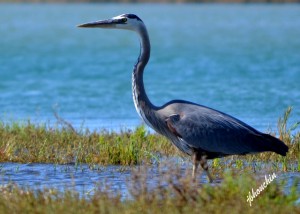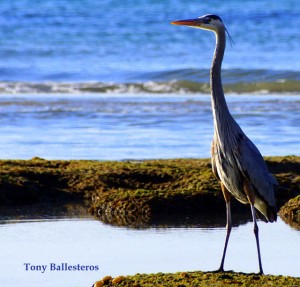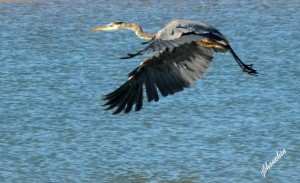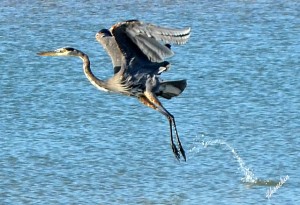We are so lucky here in our little slice of paradise by the sea because many beautiful birds also call Puerto Peñasco home, and many more spend the winter months with us. So between the “Snow Birds” (literally) and the permanent resident birds we have the gift of  being able to look into the sky or onto the beach, even into the trees to find the natural vista of beauty accentuated by a plethora of color and grace in flight to punctuate the phenomena of sunsets, cloud shapes and the ebbing tides.
being able to look into the sky or onto the beach, even into the trees to find the natural vista of beauty accentuated by a plethora of color and grace in flight to punctuate the phenomena of sunsets, cloud shapes and the ebbing tides.
Of the hundreds of aviary species around us here, many of which so rare or endangered that they are protected by international laws, one of the largest and most graceful is the Great Blue Heron. A bird of such uncommon beauty no matter how many times we are blessed with its presence, we stop in our tracks to appreciate the sight.
Although the same holds true for two others of the heron family (Ardeidae), the Great Egret and the Snowy Egret, both of which resemble the Heron in shape, but show themselves in pure white feathers, today we’ll share some facts about the Great Blue Heron and include more about the Great and Snowy Egrets in a future blog.
- Great Blue Herons are easily recognized even from a distance as they appear blue-gray with a wide black stripe over the eye and
 long black legs. When extended, their necks sometime appear a rusty tan; bills are strong, yellow or yellow and grey dagger-like structures.
long black legs. When extended, their necks sometime appear a rusty tan; bills are strong, yellow or yellow and grey dagger-like structures. - With their neck fully extended upward the Great Blue Heron can reach up to 4 ½ feet in height with a wing span of 5 to 6 feet. Despite that size, they only weight 5 or 6 pounds due in part to their hollow bones (a feature shared by all birds).
 In flight, Great Blues have a slow, deep wing beat and fly with their necks curled in an “S” back into their bodies for aerodynamics and their long black legs trail behind the tail. Even with such a slow wing beat, these birds can cruise at 20 to 30 miles an hour and can push it up to 35 mph.
In flight, Great Blues have a slow, deep wing beat and fly with their necks curled in an “S” back into their bodies for aerodynamics and their long black legs trail behind the tail. Even with such a slow wing beat, these birds can cruise at 20 to 30 miles an hour and can push it up to 35 mph.- It seems all animals have a special characteristic that has evolved to assist them with their survival duties. The Great Blue is no different. These Herons have special patches of powder down feathers that grow and fray on their chest which they can rake with their foot and spread the powder along their underbelly and on their prey to clean off the slime and oils.
- You can find Great Blues early mornings during low tide carefully wading (hunting) in the tide pools. They might wade with ultra slow movement looking for small fish or crustaceans or stand completely motionless for long periods waiting for unwitting prey to swim or crawl by which they will pierce with lightening fast strikes. Even though known for hunting fish, Great Blue Herons will feed on small animals like mice, even small birds if the opportunity arises. They swallow their prey whole and despite their long slender neck size can swallow prey much wider, although they’ve been known to choke to death by getting too ambitious
 with their dining selection.
with their dining selection. - Finally, even though Herons nest in groups called “Heronries” they usually hunt alone, and during nesting season are very protective of their feeding areas. They will aggressively protect that area from other birds of any species and humans. It is unsafe to handle these Herons because the lightening fast striking ability of their sharp bills can cause serious injury.
To learn more about the Great Blue Heron visit:
Cornell Lab of Ornithology www.allaboutbirds.org
Seattle Audubon Society www.seattleaudubon.org
National Geographic http://animals.nationalgeographic.com
This blog is powered by www.sonoranresorts.mx, Jim Ringquist, Director of Sales and Marketing.




